Characterizing Farmers and Farming System in Kilombero Valley Floodplain, Tanzania
Abstract
1. Introduction
2. Material and Method
2.1. Study Site
2.2. Data and Variable Selection
2.3. Methods of Typology Construction
3. Results
3.1. Descriptive Statistics
3.2. Principal Component Analysis
3.3. Cluster Analysis
3.4. Validation of Typology
4. Discussion
5. Conclusions
Author Contributions
Funding
Conflicts of Interest
Abbreviations
| SAGCOT | Southern Agricultural Growth Corridor of Tanzania |
| GOT | Government of Tanzania |
| TSh | Tanzanian shelling |
| KVF | Kilombero Valley Floodplain |
| MCRP | Monocrop rice producer |
| PCA | Principal component analysis |
| TLU | Tropical livestock unit |
| SD | Standard deviation |
| CV | Coefficient of variation |
| GIS | Geographic information system |
Appendix A
Appendix A.1. Table of Discramintory Variables
| Cluster Mean | Overall Mean | Cluster SD | Overall SD | p Value | |
|---|---|---|---|---|---|
| Cluster I [ Monocrop Rice Producers] [68.4%] | |||||
| Share of land allocated to rice | 91.47 | 79.18 | 11.02 | 23.91 | 0.00 |
| Percent of labor hired | 43.41 | 36.80 | 33.66 | 33.13 | 0.00 |
| Commercialization index | 49.87 | 47.05 | 23.45 | 24.75 | 0.00 |
| Total labor person-days (hayear) | 322.11 | 297.39 | 259.15 | 241.17 | 0.01 |
| Total expenditure on Agro-inputs (000 Tsh) (ha) | 36.358 | 29.998 | 92.565 | 79.086 | 0.05 |
| Household size | 4.81 | 5.05 | 1.64 | 1.98 | 0.00 |
| Share of land allocated to vegetables | 1.42 | 3.53 | 5.22 | 11.51 | 0.00 |
| Farm size in Ha | 1.97 | 2.37 | 1.51 | 2.17 | 0.00 |
| TLU | 0.23 | 0.68 | 0.67 | 2.24 | 0.00 |
| Share of land allocated to maize | 3.41 | 13.85 | 7.41 | 21.37 | 0.00 |
| Cluster II [Diversifier] [25.2%] | |||||
| Share of land allocated to maize | 39.66 | 13.85 | 24.43 | 21.37 | 0.00 |
| Share of land allocated to vegetables | 9.98 | 3.53 | 19.84 | 11.51 | 0.00 |
| Percent of labor Hired | 24.41 | 36.80 | 27.43 | 33.13 | 0.00 |
| Share of land allocated to rice | 47.00 | 79.18 | 19.87 | 23.91 | 0.00 |
| Cluster III [Agropastoralist] [6.4%] | |||||
| TLU | 7.07 | 0.68 | 5.36 | 2.24 | 0.00 |
| Farm size in Ha | 7.67 | 2.37 | 3.06 | 2.17 | 0.00 |
| Household size | 8.44 | 5.05 | 2.22 | 1.98 | 0.00 |
| Share of land allocated to maize | 23.99 | 13.85 | 17.67 | 21.37 | 0.04 |
| Total labor person-days (hayear) | 151.53 | 297.39 | 121.15 | 241.17 | 0.01 |
| Years of schooling | 4.89 | 6.44 | 3.45 | 2.47 | 0.01 |
| Commercialization index | 31.09 | 47.05 | 23.95 | 24.75 | 0.00 |
| Percent of labor hired | 14.81 | 36.80 | 22.86 | 33.13 | 0.00 |
Appendix A.2. Box Plot of Validation Cluster
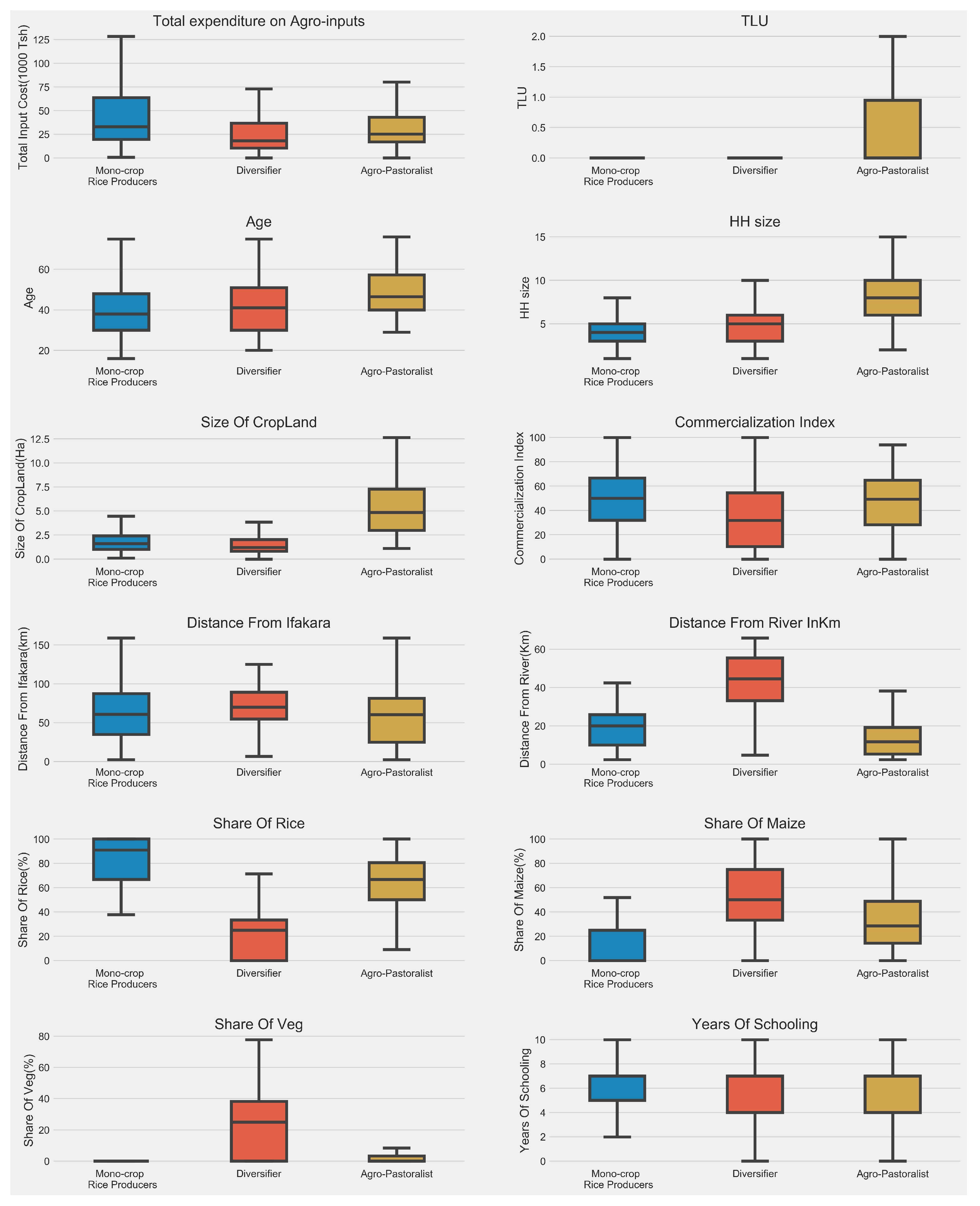
References
- Milder, J.C.; Buck, L.E.; Hart, A. Applying an Agriculture Green Growth Approach in the SAGCOT Clusters: Challenges and Opportunities in Kilombero, Ihemi and Mbarali; Technical Report; SAGCOT Centre: Dar es Salaam, Tanzania, 2013. [Google Scholar]
- Environmental Resources Management. Southern Agricultural Growth Corridor of Tanzania (SAGCOT): Strategic Regional Environmental and Social Assessment; RFP Number: A/082/hq/S/Sagt/pmu/7, ERM Project Number: 0159588; Environmental Resources Management: Dar es Salaam, Tanzania, 2012; p. 144. [Google Scholar]
- Bamford, A.; Ferrol-Schulte, D.; Smith, H. The Status of the Ruipa Corridor between the Selous Game Reserve and the Udzungwa Mountains; Technical Report; Frontier Tanzania: Dar es Salaam, Tanzania, 2010. [Google Scholar]
- Dinesen, L. Kilombero Valley Floodplain (Tanzania). In The Wetland Book: II: Distribution, Description and Conservation; Finlayson, C.M., Milton, G.R., Prentice, R.C., Davidson, N.C., Eds.; Springer Netherlands: Dordrecht, The Netherlands, 2016; pp. 1–8. [Google Scholar]
- Kato, F. Development of a major rice cultivation area in the Kilombero Valley, Tanzania. Afr. Study Monogr. 2007, 36, 3–18. [Google Scholar] [CrossRef]
- Nindi, S.J.; Maliti, H.; Bakari, S.; Kija, H.; Machoke, M. Conflicts Over Land and Water Resources in the Kilombero Valley Floodplain, Tanzania. Afr. Study Monogr. 2014, 50, 173–190. [Google Scholar]
- Kangalawe, R.Y.M.; Liwenga, E.T. Livelihoods in the wetlands of Kilombero Valley in Tanzania: Opportunities and challenges to integrated water resource management. Phys. Chem. Earth 2005, 30, 968–975. [Google Scholar] [CrossRef]
- Mombo, F.; Speelman, S.; Kessy, J.; Hella, J.; Van Huylenbroeck, G. Determinants of access patterns to goods and services from wetlands in Tanzania and the impact on sustainable wetland management. Afr. J. Agric. Res. 2012, 7, 5585–5593. [Google Scholar] [CrossRef]
- Msofe, N.K.; Sheng, L.; Lyimo, J.; Msofe, N.K.; Sheng, L.; Lyimo, J. Land Use Change Trends and Their Driving Forces in the Kilombero Valley Floodplain, Southeastern Tanzania. Sustainability 2019, 11, 505. [Google Scholar] [CrossRef]
- Ronald, B.; Dulle, F.; Honesta, N. Assessment of the Information Needs of Rice Farmers in Tanzania: A Case Study of Kilombero District, Morogoro. Libr. Philos. Pract. e-J. 2014, 1071, 1–33. [Google Scholar]
- Jenkins, B. Mobilizing the Southern Agricultural Growth Corridor of Tanzania: A Case Study; The CSR Initiative at the Harvard Kennedy School: Cambridge, MA, USA, 2012. [Google Scholar]
- Schnitzer, P.; Azzarri, C. Tanzania Agricultural Snapshot 2007/8; Working Paper; HarvestChoice-International Food Policy Research Institute: Washington, DC, USA, 2014. [Google Scholar]
- Martin-Prével, A.; Frédéric, M.; Mittal, A. The Unholy Alliance, Five Western Donors Shape a Pro-Corporate Agenda for African Agriculture; The Oakland Institute: Oakland, CA, USA, 2016; pp. 1–28. [Google Scholar]
- Milder, J.C.; Buck, L.E.; Hart, A.K.; Scherr, S.J.; Shames, S.A. A framework for Agriculture Green Growth: Greenprint for the Southern Agricultural Growth Corridor of Tanzania (SAGCOT); SAGCOT Centre: Dar es Salaam, Tanzania, 2013. [Google Scholar]
- New Markets Lab; SAGCOT. A Legal Guide to Strengthen Tanzania’s Seed and Input Markets; Alliance for a Green Revolution in Africa (AGRA): Nairobi, Kenya, 2017; p. 148. [Google Scholar]
- Mombo, F.; Speelman, S.; Hella, J.; Van Huylenbroeck, G. How characteristics of wetlands resource users and associated institutions influence the sustainable management of wetlands in Tanzania. Land Use Policy 2013, 35, 8–15. [Google Scholar] [CrossRef]
- Saravia Matus, S.; Cimpoeis, D.; Ronzon, T. Literature Review and Proposal for an International Typology of Agricultural Holdings; A World Agricultures Watch Report; Food & Agriculture Org.: Rome, Italy, 2013. [Google Scholar]
- Dixon, J.A.; Gibbon, D.P.; Gulliver, A. Farming Systems and Poverty: Improving Farmers’ Livelihoods in a Changing World; Food & Agriculture Org.: Rome, Italy, 2001. [Google Scholar]
- AGRA. African Agriculture Status Report: Focus on Staple Crops; Technical Report; Alliance for a Green Revolution in Africa (AGRA): Nairobi, Kenya, 2013. [Google Scholar]
- AGRA. African Agriculture Status Report: The Business of Smallholder Agriculture in Sub-Saharan Africa(Issue 5); Technical Report; Alliance for a Green Revolution in Africa (AGRA): Nairobi, Kenya, 2017. [Google Scholar]
- Garrity, D.; Dixon, J.; Boffa, J.M. Understanding African Farming Systems; Invited paper, Food Security in Africa: Bridging research and Practise; Australian International Food Security Centre: Canberra, Australia, 2012; pp. 1–50. [Google Scholar]
- Whitfield, S.; Dixon, J.L.; Mulenga, B.P.; Ngoma, H. Conceptualising farming systems for agricultural development research: Cases from Eastern and Southern Africa. Agric. Syst. 2015, 133, 54–62. [Google Scholar] [CrossRef]
- Osabuohien, E.S.; Efobi, U.R.; Herrmann, R.T.; Gitau, C.M. Female labor outcomes and large-scale agricultural land investments: Macro-micro evidencefrom Tanzania. Land Use Policy 2019, 82, 716–728. [Google Scholar] [CrossRef]
- Herrmann, R.T. Large-Scale Agricultural Investments and Smallholder Welfare: A Comparison of Wage Labor and Outgrower Channels in Tanzania. World Dev. 2017, 90, 294–310. [Google Scholar] [CrossRef]
- Nakano, Y.; Tanaka, Y.; Otsuka, K. Impact of training on the intensification of rice farming: Evidence from rainfed areas in Tanzania. Agric. Econ. 2018, 49, 193–202. [Google Scholar] [CrossRef]
- Bidogeza, J.C.; Berentsen, P.B.M.; De Graaff, J.; Oude Lansink, A.G.J.M. A typology of farm households for the Umutara Province in Rwanda. Food Secur. 2009, 1, 321–335. [Google Scholar] [CrossRef]
- Gebauer, R.H. Socio-economic classification of farm households—Conceptual, methodical and empirical considerations. Eur. Rev. Agric. Econ. 1987, 14, 261–283. [Google Scholar] [CrossRef]
- Guiomar, N.; Godinho, S.; Pinto-Correia, T.; Almeida, M.; Bartolini, F.; Bezák, P.; Biró, M.; Bjørkhaug, H.; Bojnec, S.; Brunori, G.; et al. Typology and distribution of small farms in Europe: Towards a better picture. Land Use Policy 2018, 75, 784–798. [Google Scholar] [CrossRef]
- Köbrich, C.; Rehman, T.; Khan, M. Typification of farming systems for constructing representative farm models: Two illustrations of the application of multi-variate analyses in Chile and Pakistan. Agric. Syst. 2003, 76, 141–157. [Google Scholar] [CrossRef]
- Goswami, R.; Chatterjee, S.; Prasad, B. Farm types and their economic characterization in complex agro-ecosystems for informed extension intervention: Study from coastal West Bengal, India. Agric. Food Econ. 2014, 2. [Google Scholar] [CrossRef]
- Kuivanen, K.S.; Michalscheck, M.; Descheemaeker, K.; Adjei-Nsiah, S.; Mellon-Bedi, S.; Groot, J.C.J.; Alvarez, S. A comparison of statistical and participatory clustering of smallholder farming systems—A case study in Northern Ghana. J. Rural Stud. 2016, 45, 184–198. [Google Scholar] [CrossRef]
- Takeshima, H.; Nin-Pratt, A.; Diao, X.; Nin-Pratt, A.; Diao, X.; Nin-Pratt, A.; Diao, X. Mechanization and agricultural technology evolution, agricultural intensification in Sub-Saharan Africa: Typology of agricultural mechanization in Nigeria. Am. J. Agric. Econ. 2013, 95, 1230–1236. [Google Scholar] [CrossRef]
- Valbuena, D.; Verburg, P.H.; Bregt, A.K. A method to define a typology for agent-based analysis in regional land-use research. Agric. Ecosyst. Environ. 2008, 128, 27–36. [Google Scholar] [CrossRef]
- Berre, D.; Corbeels, M.; Rusinamhodzi, L.; Mutenje, M.; Thierfelder, C.; Lopez-Ridaura, S. Thinking beyond agronomic yield gap: Smallholder farm efficiency under contrasted livelihood strategies in Malawi. Field Crops Res. 2017, 214, 113–122. [Google Scholar] [CrossRef]
- Kuivanen, K.S.; Alvarez, S.; Michalscheck, M.; Adjei-Nsiah, S.; Descheemaeker, K.; Mellon-Bedi, S.; Groot, J.C. Characterising the diversity of smallholder farming systems and their constraints and opportunities for innovation: A case study from the Northern Region, Ghana. NJAS-Wagen. J. Life Sci. 2016, 78, 153–166. [Google Scholar] [CrossRef]
- Pacini, G.C.; Colucci, D.; Baudron, F.; Righi, E.; Corbeels, M.; Tittonell, P.; Stefanini, F.M. Combining multi-dimensional scaling and cluster analysis to describe the diversity of rural households. Exp. Agric. 2014, 50, 376–397. [Google Scholar] [CrossRef]
- Pienaar, L.; Traub, L.N. Understanding the Smallholder Farmer in South Africa: Towards a Sustainable Livelihoods Classification. In Proceedings of the 29th International Conference on Agricultural Economics, Milan, Italy, 8–14 August 2015; International Association of Agricultural Economists: Milan, Italy, 2015. [Google Scholar]
- Tittonell, P.; Muriuki, A.; Shepherd, K.; Mugendi, D.; Kaizzi, K.; Okeyo, J. The diversity of rural livelihoods and their influence on soil fertility in agricultural systems of East Africa—A typology of smallholder farms. Agric. Syst. 2010, 103, 83–97. [Google Scholar] [CrossRef]
- Andersen, E.; Elbersen, B.; Godeschalk, F.; Verhoog, D. Farm management indicators and farm typologies as a basis for assessments in a changing policy environment. J. Environ. Manag. 2007, 82, 353–362. [Google Scholar] [CrossRef]
- Daloglu, I.; Nassauer, J.I.; Riolo, R.L.; Scavia, D. Development of a farmer typology of agricultural conservation behavior in the american corn belt. Agric. Syst. 2014, 129, 93–102. [Google Scholar] [CrossRef]
- Hazeu, G.W.; Metzger, M.J.; Mücher, C.A.; Perez-Soba, M.; Renetzeder, C.; Andersen, E. European environmental stratifications and typologies: An overview. Agric. Ecosyst. Environ. 2011, 142, 29–39. [Google Scholar] [CrossRef]
- Nin-Pratt, A.; ElDidi, H.; Breisinger, C. Farm Households in Egypt: A Typology for Assessing Vulnerability to Climate Change; MENA RP Working Paper 12; International Food Policy Research Institute (IFPRI): Washington, DC, USA; Cairo, Egypt, 2018; 53p. [Google Scholar]
- Shukla, R.; Agarwal, A.; Sachdeva, K.; Kurths, J.; Joshi, P. Climate change perception: An analysis of climate change and risk perceptions among farmer types of Indian Western Himalayas. Clim. Chang. 2019, 152, 103–119. [Google Scholar] [CrossRef]
- Wezel, A.; Casagrande, M.; Celette, F.; Vian, J.F.; Ferrer, A.; Peigné, J. Agroecological practices for sustainable agriculture. A review. Agron. Sustain. Dev. 2014, 34, 1–20. [Google Scholar] [CrossRef]
- Therond, O.; Duru, M.; Roger-Estrade, J.; Richard, G. A new analytical framework of farming system and agriculture model diversities. A review. Agron. Sustain. Dev. 2017, 37, 21. [Google Scholar] [CrossRef]
- Alvarez, S.; Paas, W.; Descheemaeker, K.; Tittonell, P.; Groot, J. Typology Construction, a Way of Dealing with Farm Diversity General Guidelines for Humidtropics; Report for the CGIAR Research Program on Integrated Systems for the Humid Tropics; Plant Sciences Group, Wageningen University: Wageningen, The Netherlands, 2014; pp. 1–37. [Google Scholar]
- Hansen, P.; Jaumard, B. Cluster analysis and mathematical programming. Math. Program. 1997, 79, 191–215. [Google Scholar] [CrossRef]
- Husson, F.; Le, S.; Pages, J. Exploratory Multivariate Analysis by Example Using R; A CHAPMAN & HALL BOOK: New York, NY, USA, 2017; p. 248. [Google Scholar]
- Alvarez, S.; Timler, C.J.; Michalscheck, M.; Paas, W.; Descheemaeker, K.; Tittonell, P.; Andersson, J.A.; Groot, J.C.J. Capturing farm diversity with hypothesis-based typologies: An innovative methodological framework for farming system typology development. PLoS ONE 2018, 13, e0194757. [Google Scholar] [CrossRef] [PubMed]
- Le, Q.B.; Park, S.J.; Vlek, P.L.G. Land Use Dynamic Simulator (LUDAS): A multi-agent system model for simulating spatio-temporal dynamics of coupled human-landscape system. 2. Scenario-based application for impact assessment of land-use policies. Ecol. Inform. 2010, 5, 203–221. [Google Scholar] [CrossRef]
- Villamor, G.B.; van Noordwijk, M.; Le, Q.B.; Lusiana, B.; Matthews, R.; Vlek, P.L.G. Diversity deficits in modelled landscape mosaics. Ecol. Inform. 2011, 6, 73–82. [Google Scholar] [CrossRef]
- Wilson, E.; Mcinnes, R.; Mbaga, P.; Ouedraogo, P. Kilombero Valley, United Republic of Tanzania: Ramsar Advisory Mission Report; Technical Report; The Ramsar Convention Secretariat: Gland, Switzerland, 2017. [Google Scholar]
- Lyon, S.W.; Koutsouris, A.; Scheibler, F.; Jarsjö, J.; Mbanguka, R.; Tumbo, M.; Robert, K.K.; Sharma, A.N.; van der Velde, Y. Interpreting characteristic drainage timescale variability across Kilombero Valley, Tanzania. Hydrol. Process. 2015, 29, 1912–1924. [Google Scholar] [CrossRef]
- Ntongani, W.A.; Munishi, P.K.T.; More, S.R.; Kashaigili, J.J. Local Knowledge on the Influence of Land Use/Cover Changes and Conservation Threats on Avian Community in the Kilombero Wetlands, Tanzania. Open J. Ecol. 2014, 4, 723. [Google Scholar] [CrossRef]
- RAMSAR. Information Sheet on Ramsar Wetland: The Kilombero Valley Floodplain; The Ramsar Convention Secretariat: Gland, Switzerland, 2002; pp. 1–17. [Google Scholar]
- Munishi, P.K.T.; Chuwa, J.J.; Kilungu, H.; Moe, S.R.; Temu, R.P.C. Management Effectiveness and Conservation Initiatives in the Kilombero Valley Flood Plains Ramsar Site, Tanzania. Tanzan. J. For. Nat. Conserv. 2012, 81, 1–10. [Google Scholar]
- KILORWEMP. Technical Advisory Services for Biodiversity Conservation and Wetland Management in Kilombero Valley RAMSAR Site, Tanzania:Pastoralism Diagnostic Study; Technical Report; KILORWEMP Project Implementation Unit: Dar es Salaam, Tanzania, 2017. [Google Scholar]
- Blache, A. Grabbing Land, Catching Votes! Land and the 2015 Election Campaign in Kilombero District, Tanzania. East Afr. Rev. 2020, 53. Available online: http://journals.openedition.org/eastafrica/791 (accessed on 31 August 2020).
- National Bureau of Statistics. 2012 Population and Housing Census; Population Distribution by Adminstrative Areas; National Bureau of Statistics: Dar es Salaam, Tanzania, 2013.
- MALF. Tanzania Livelihood Baseline Profile: Kilombero-Ulanga-Lusewa Paddy, Maize, and Cassava Livelihood Zone; Zone Discription 43; Ministry of Agriculture Livestock and Fisheries— Agriculture Department: Dar es Salaam, Tanzania, 2015.
- Jones, T.; Bamford, A.J.; Ferrol-Schulte, D.; Hieronimo, P.; McWilliam, N.; Rovero, F. Vanishing Wildlife Corridors and Options for Restoration: A Case Study from Tanzania. Trop. Conserv. Sci. 2012, 5, 463–474. [Google Scholar] [CrossRef]
- Jun, C.; Ban, Y.; Li, S. China: Open access to Earth land-cover map. Nature 2014, 514, 434. [Google Scholar] [CrossRef]
- Scoones, I. Sustainable Rural Livelihood: A Framework For Analysis IDS WORKING PAPER 72; IDS: Brighton, UK, 1998. [Google Scholar]
- Iraizoz, B.; Gorton, M.; Davidova, S. Segmenting farms for analysing agricultural trajectories: A case study of the Navarra region in Spain. Agric. Syst. 2007, 93, 143–169. [Google Scholar] [CrossRef]
- Schmitzberger, I.; Wrbka, T.; Steurer, B.; Aschenbrenner, G.; Peterseil, J.; Zechmeister, H. How farming styles influence biodiversity maintenance in Austrian agricultural landscapes. Agric. Ecosyst. Environ. 2005, 108, 274–290. [Google Scholar] [CrossRef]
- Takeshima, H.; Edeh, H. Typology of Farm Households and Irrigation Systems: Some Evidence from Nigeria. Ssrn 2013. [Google Scholar] [CrossRef][Green Version]
- Takeshima, H. Understanding Irrigation System Diversity in Nigeria: A Modified Cluster Analysis Approach. Irrig. Drain. 2016, 65, 601–612. [Google Scholar] [CrossRef]
- Singh, C.; Dorward, P.; Osbahr, H. Developing a holistic approach to the analysis of farmer decision-making: Implications for adaptation policy and practice in developing countries. Land Use Policy 2016, 59, 329–343. [Google Scholar] [CrossRef]
- Lacoste, M.; Lawes, R.; Ducourtieux, O.; Flower, K. Assessing regional farming system diversity using a mixed methods typology: The value of comparative agriculture tested in broadacre Australia. Geoforum 2018, 90, 183–205. [Google Scholar] [CrossRef]
- Dunteman, G.H. Principal Components Analysis; Number 69; SAGE Publications, Inc.: Newbury Park, CA, USA, 1989. [Google Scholar]
- Hair, J.F., Jr.; Black, W.C.; Babin, B.J.; Anderson, R.E. Multivariate Data Analysis, 7th ed.; Essex CM20 2JE; Pearson Education Limited: London, UK, 2014; pp. 1–739. [Google Scholar]
- Husson, F.; Josse, J.; Pages, J. Principal Component Methods—Hierarchical Clustering—Partitional Clustering: Why Would We Need to Choose for Visualizing Data? Technical Report 1; Applied Mathematics Department: Rennes, France, 2010. [Google Scholar] [CrossRef]
- Everitt, B.S.; Landau, S.; Leese, M.; Stahl, D. Cluster Analysis 5th Addition2011, 5th ed.; John Wiley & Sons, Ltd. Registered: West Sussex, UK, 2011; p. 848. [Google Scholar] [CrossRef]
- Härdle, W.K.; Simar, L. Applied Multivariate Statistical Analysis; Pearson: Upper Saddle River, NJ, USA, 2013; pp. 1–516. [Google Scholar] [CrossRef]
- Le, S.; Josse, J.; Husson, F. FactoMineR: An R Package for Multivariate Analysis. J. Stat. Softw. Artic. 2008, 25, 1–18. [Google Scholar] [CrossRef]
- Kassambara, A.; Mundt, F. Factoextra: Extract and visualize the results of multivariate data analyses. R Package Version 2016, 1, 337–354. [Google Scholar]
- R Core Team. R: A Language and Environment for Statistical Computing; R Foundation for Statistical Computing: Vienna, Austria, 2018. [Google Scholar]
- TNBS. National Sample Census of Agriculture 2007/08; Tanzania National Bureau of Statistics: Dar es selaam, Tanzania, 2009; Volume V, pp. 1–345.
- Government of Tanzania. National Agriculture Policy; Technical Report; Ministry of Agriculture Food Security and Cooperatives: Dar es selaam, Tanzania, 2016.
- NRGF. Natural Resource Governance in Kilombero Cluster and the SAGCOT INITIATIVE: An Assessment of Key Issues and Recommendations for Action; Technical Report; CEESP and IUCN: Gland, Switzerland, 2017. [Google Scholar]
- Wineman, A.; Jayne, T.S.; Isinika Modamba, E.; Kray, H. The changing face of agriculture in Tanzania: Indicators of transformation. Dev. Policy Rev. 2020. [Google Scholar] [CrossRef]
- URT. Agricultural Sector Development Strategy-II 2015/2016–2024/2025; Technical Report; United Republic of Tanzania: Dar es selaam, Tanzania, 2016.
- URT. (SAGCOT) Investment Project Public Notice. Re-Disclosure of Environmental and Social Management Framework (ESMF); Technical Report; Prime Minister’s Office: Dar es selaam, Tanzania, 2011.
- AgDevCo.; Prorustica. Southern Agricultural Growth Corridor of Tanzania Investment Blueprint; Technical Report; AgDevCo.: Dar es selaam, Tanzania, 2011. [Google Scholar]
- Bergius, M.; Benjaminsen, T.A.; Maganga, F.; Buhaug, H. Green economy, degradation narratives, and land-use conflicts in Tanzania. World Dev. 2020, 129, 104850. [Google Scholar] [CrossRef]
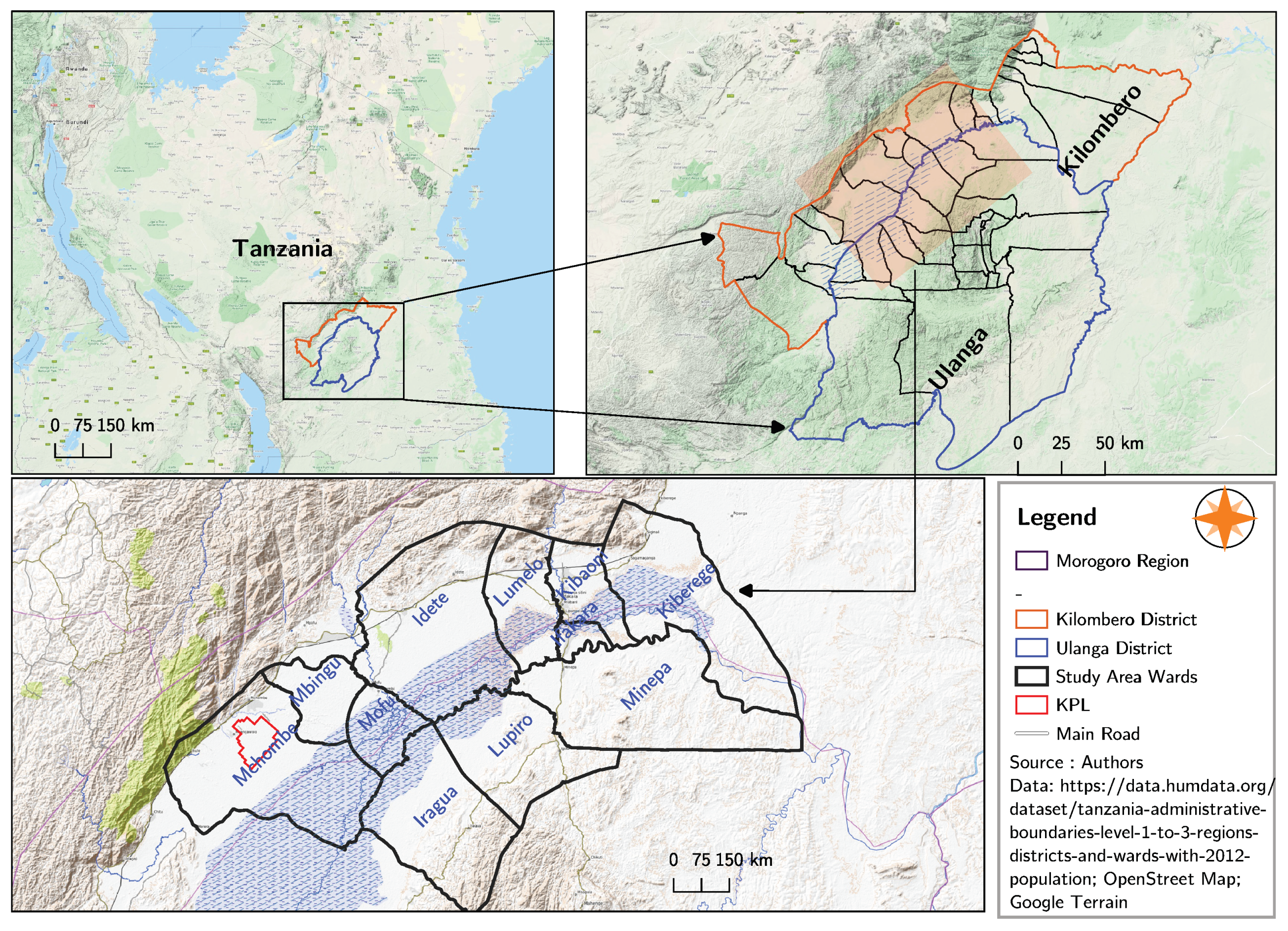
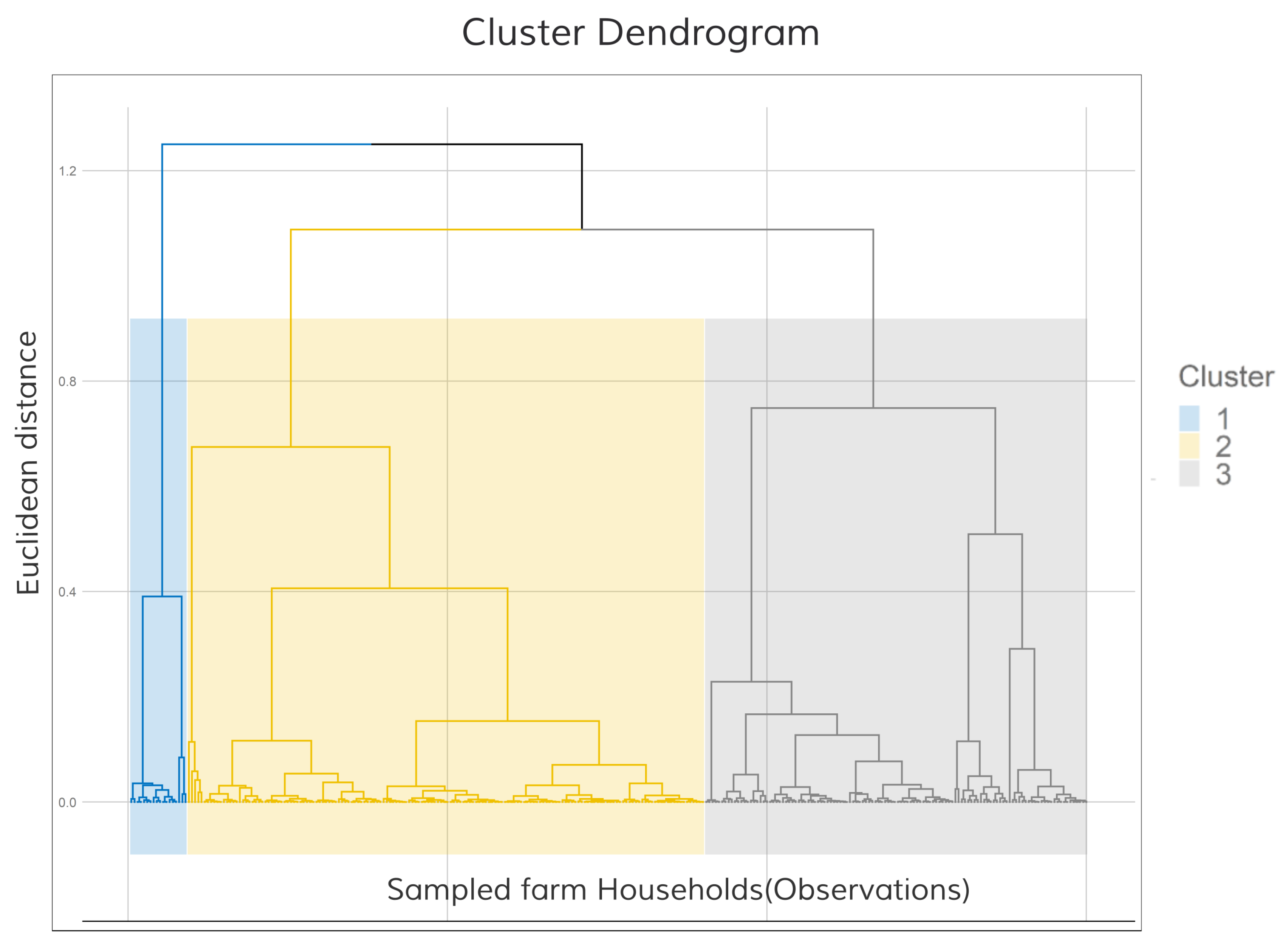
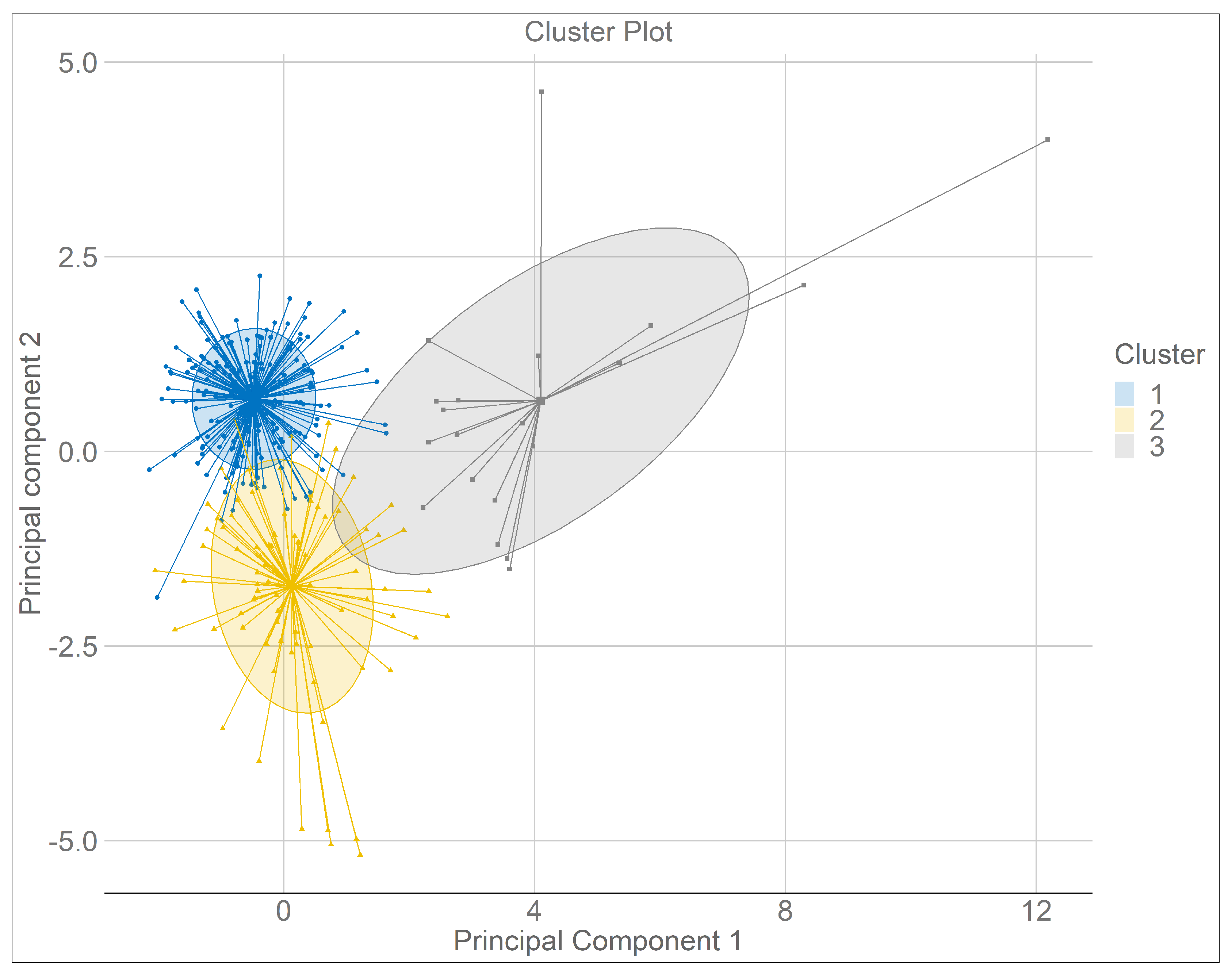
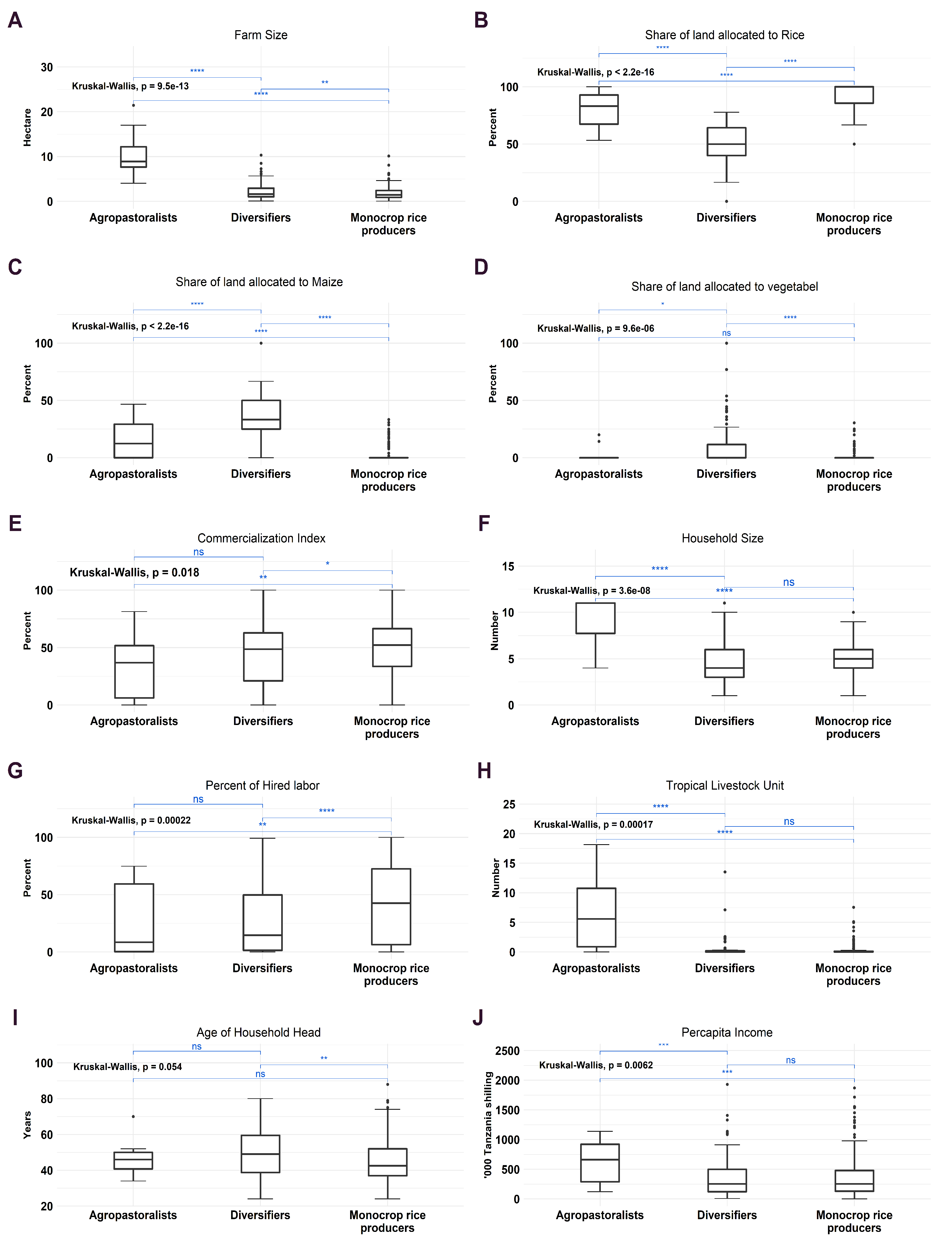
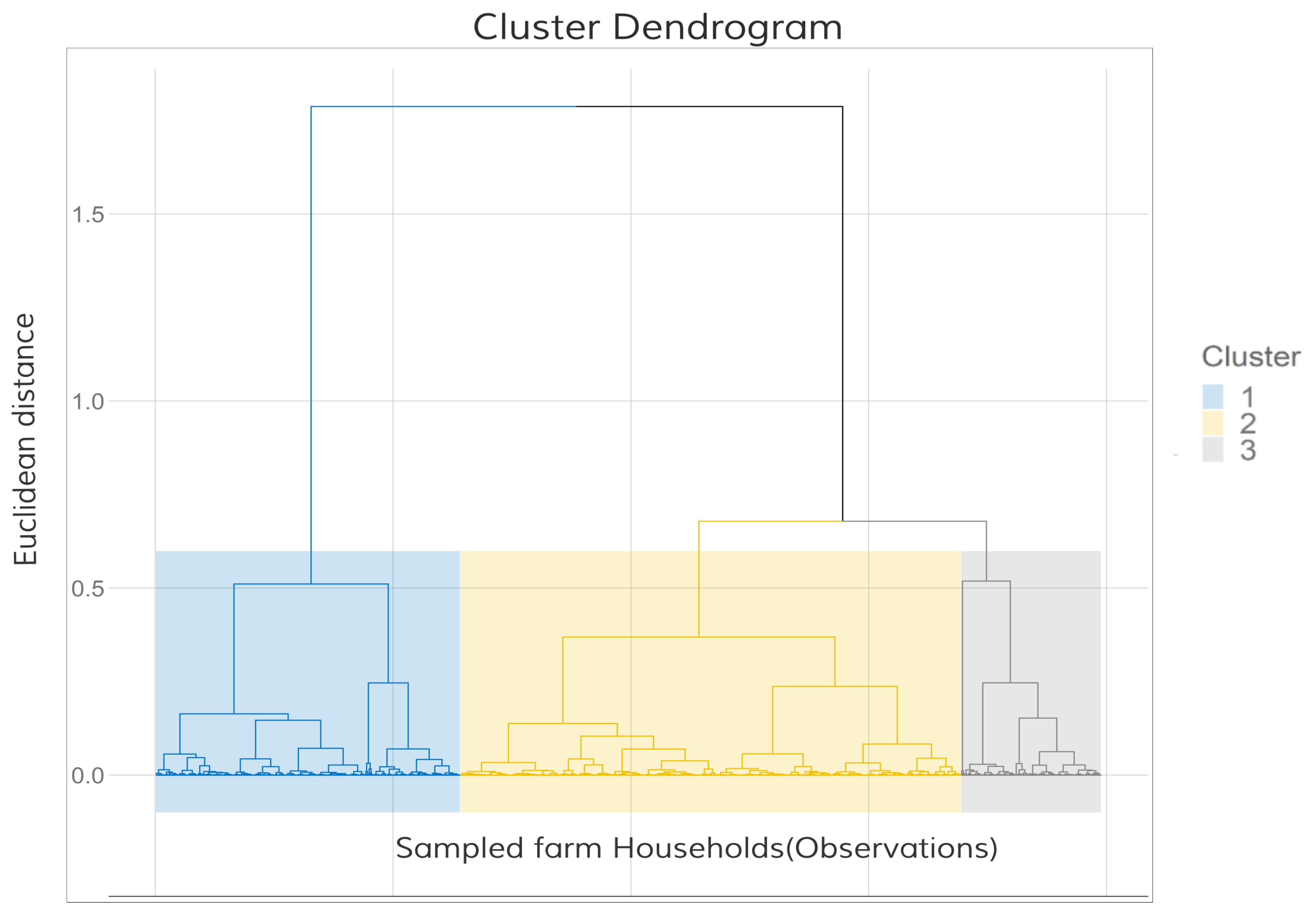
| Variable | Description | Unit | Mean (SD) | CV |
|---|---|---|---|---|
| Age | The age of the household head | years | 46.53 (12.92) | 0.28 |
| Household size | Number of individuals in the household | number | 5.12 (2.15) | 0.42 |
| Share of rice | Percentage of the total cultivated land allocated to rice | % | 78.77 (23.93) | 0.3 |
| Share of maize | Percentage of the total cultivated land allocated to maize | % | 13.92 (21.19) | 1.52 |
| Farm size | The size of farm land owned | ha | 2.61 (2.78) | 1.06 |
| TLU | Total Tropical livestock unit | TLU | 1.46 (6.56) | 4.49 |
| Percent hired | Share of labor hired | % | 37.25 (33.21) | 0.89 |
| Commercialization index | An index of commercialization | index | 47.05 (24.8) | 0.53 |
| Expenditure on Agro-inputs | Overall input intensity, measured as the total value of inputs (Fertilizer, seed and agro-chemicals) (ha) | TSh | 64,984.41 (349,645.18) | 5.38 |
| Distance river | Distance from plot to the nearest river | km | 2.61 (3.68) | 1.41 |
| Off Farm income | Percentage of Income from non-farm sources | % | 9.78 (21.74) | 2.22 |
| Share of Vegetable | Percentage of the total cultivated land allocated to vegetables | % | 3.8 (11.92) | 3.14 |
| Per capita income | Per capita income per year | TSh (000) | 516.37 (1124.84) | 2.18 |
| Total labor person days | Total labor use in the farm (ha) | Man-days | 317.36 (337.07) | 1.06 |
| Years of schooling | Total number of years in school | years | 6.37 (2.56) | 0.4 |
| Variables | Correlation between a Variable and a Principal Component | |||||
|---|---|---|---|---|---|---|
| PC1 | PC2 | PC3 | PC4 | PC5 | PC6 | |
| Age of household head | 0.4087 | 0.0818 | −0.2588 | 0.0385 | −0.6458 | −0.1076 |
| Household size | 0.5634 | 0.3491 | 0.0777 | 0.1578 | 0.2715 | −0.1077 |
| Share of land allocated to rice | −0.4839 | 0.7854 | −0.3324 | 0.016 | 0.0316 | 0.0328 |
| Share of land allocated to maize | 0.5246 | −0.6634 | 0.2328 | −0.2004 | 0.2237 | 0.1673 |
| Farm size owned in Ha | 0.5328 | 0.432 | 0.4265 | 0.0602 | 0.1217 | −0.1854 |
| Tropical livestock unit | 0.5591 | 0.3199 | 0.0082 | 0.29 | 0.3321 | 0.0207 |
| Share of hired labor | −0.4772 | 0.1536 | 0.4861 | 0.054 | −0.1049 | −0.2018 |
| Commercialization index | −0.4606 | −0.1168 | 0.0823 | 0.3672 | 0.2311 | −0.3844 |
| Total expenditure in agro-inputs (000 Tsh) | −0.2082 | 0.0056 | 0.2158 | 0.628 | 0.0495 | 0.2937 |
| Distance from the nearest river in Km | 0.0882 | −0.0691 | 0.1854 | 0.5091 | −0.0691 | 0.4159 |
| Share of Off farm income | −0.1143 | 0.1656 | 0.4908 | −0.2506 | −0.2908 | 0.2696 |
| Share of land allocated to vegetables | −0.0153 | −0.3791 | 0.3349 | 0.4172 | −0.394 | −0.3816 |
| Income per capita | −0.078 | 0.2869 | 0.5297 | −0.1394 | −0.1602 | 0.4079 |
| Total labor person days per year | −0.3336 | −0.2853 | −0.4229 | 0.1884 | 0.1535 | 0.3579 |
| Years of schooling | −0.4332 | −0.1294 | 0.4455 | −0.2871 | 0.3907 | −0.1092 |
| Eigenvalues | 2.23 | 2.01 | 1.57 | 1.28 | 1.19 | 1.02 |
| Cumulative explained variance | 16 | 30.33 | 41.56 | 50.72 | 59.27 | 66.56 |
© 2020 by the authors. Licensee MDPI, Basel, Switzerland. This article is an open access article distributed under the terms and conditions of the Creative Commons Attribution (CC BY) license (http://creativecommons.org/licenses/by/4.0/).
Share and Cite
Gebrekidan, B.H.; Heckelei, T.; Rasch, S. Characterizing Farmers and Farming System in Kilombero Valley Floodplain, Tanzania. Sustainability 2020, 12, 7114. https://doi.org/10.3390/su12177114
Gebrekidan BH, Heckelei T, Rasch S. Characterizing Farmers and Farming System in Kilombero Valley Floodplain, Tanzania. Sustainability. 2020; 12(17):7114. https://doi.org/10.3390/su12177114
Chicago/Turabian StyleGebrekidan, Bisrat Haile, Thomas Heckelei, and Sebastian Rasch. 2020. "Characterizing Farmers and Farming System in Kilombero Valley Floodplain, Tanzania" Sustainability 12, no. 17: 7114. https://doi.org/10.3390/su12177114
APA StyleGebrekidan, B. H., Heckelei, T., & Rasch, S. (2020). Characterizing Farmers and Farming System in Kilombero Valley Floodplain, Tanzania. Sustainability, 12(17), 7114. https://doi.org/10.3390/su12177114




